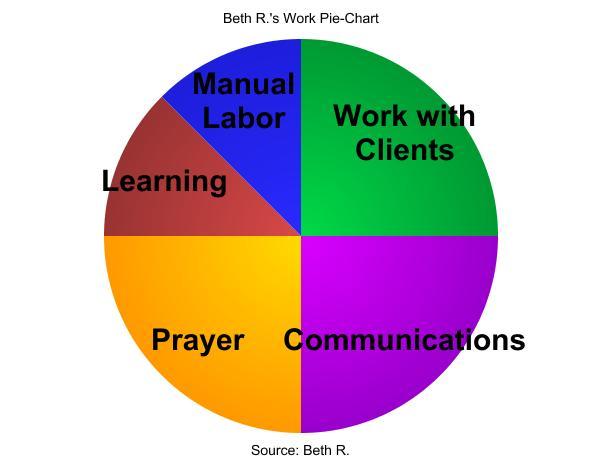
21 Apr What Color is Your Pie-Chart?

What color is YOUR pie-chart? I’m fascinated with what pie-charts can reveal to us. This pie-chart was developed with a very simple free educator’s software available through the US Department of Education. I used my own pie-chart because of confidentiality.
What color is your pie-chart?
I recently used the analogy of a pie-chart with a client to help her see how she allocated her time. She embraced it so strongly I felt it must be a good way to teach others.
So I tried it myself first, creating the simple graphic that accompanies this post. (For what each of my “slices” means, see the Notes at the end of this post.)
I am struck by the clarity offered by pie-charts for rethinking how we allocate time:
-
- The pie-chart is familiar.
- It has to be kept simple in order to work.
- It makes us group things into useful categories–not too many, not too few.
- It immediately lays bare its information.
- The quality of its information depends on how honest and clear we are about our time.
- Thus it can also show us where we aren’t honest or clear.
- It’s playful, colorful, a tool, an experiment. It’s no perfect, detailed representation of anything, and is enjoyably revised as a work in progress.
- It can show both how we spend our time and how we want to spend our time.
- It can be used to reclaim both time and work.
- It can be used to self-define abundance: many of our soul-colleagues do not want more money, they want more time. This very seldom (for us) means working “harder.”
Acknowledgement
The title of this post is a grateful reference to Richard Bolles’ What Color is Your Parachute? which has been in print since 1970, revised every five years, and translated into 22 languages!
Notes to Beth’s Work Pie-Chart
Notes are important to explaining the pie-chart to someone else, and possibly to yourself. The five slices of my work pie-chart are all the areas of my life I consider “work.” Yours will be different. For example, I don’t give parenting a slice, even though it is a lot of work!
Work with Clients (1/4 of the pie) includes:
-
- coaching
- consulting
- training
- counseling
- guiding
- advising
- writing, editing, proofreading, shepherding texts, and translating.
- All are paid.
Communications (1/4 of the pie) includes:
-
- blogging
- check-ins by email (occasionally by phone) with clients
- correspondence with soul-colleagues
- promoting Work with Clients
- negotiating work and scope of work
- accounting
- billing.
- All are unpaid and essential to Work with Clients.
Prayer (1/4 of the pie) includes:
-
- prayer per se
- meditation
- preparatory practices for meditation (eg, yogic breathing)
- Five Tibetan Rites, yoga, Feldenkrais and other movement
- contemplative reading.
- All are unpaid and essential to Work with Clients.
Learning (1/8 of the pie) includes:
-
- research in hard-copy books and journals, including identifying same online for purchase or library borrowing
- online research
- reading longer (educational/newsworthy) emails
- meetings with people with specialized knowledge
- philosophical writing
- fundraising for research and philosophical writing.
- All are unpaid and essential to Work with Clients.
- research in hard-copy books and journals, including identifying same online for purchase or library borrowing
Manual Labor (1/4) includes:
-
- cooking and preparing to cook
- cleaning: dishes, floors, myself, our clothes, our house
- recycling and taking out the trash
- repairs and upkeep to myself, our house, clothes, equipment.
- All are unpaid and essential to Work with Clients, especially because along with some of the activities in “Prayer,” they provide natural, physical-body breaks in work that is otherwise entirely sedentary.
- cooking and preparing to cook



No Comments